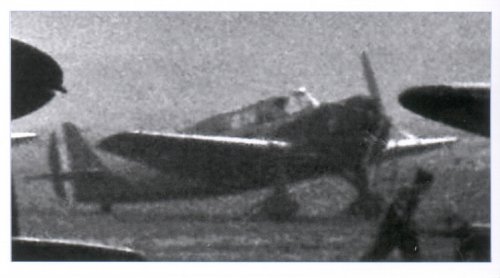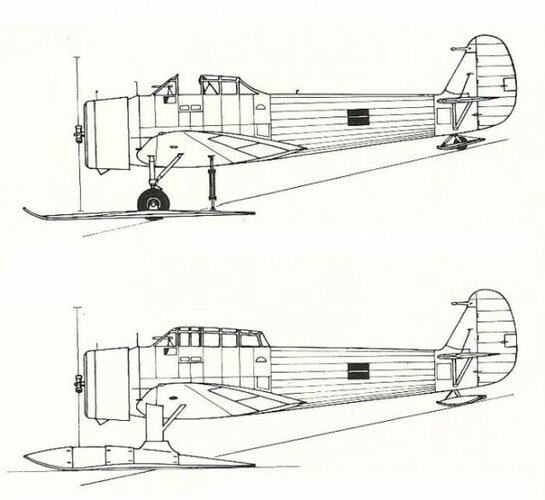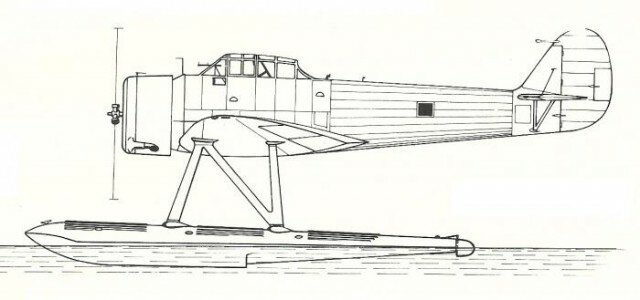Hi friends,
On 'Ali antiche' (Ancient wings) # 91, house organ of GAVS (Gruppo Amivi Velivoli Storici, member of European Aviation Preservation Council and British Aviation Preservation Council) there is an interesting features with a picture (and some enhancement of others) depicting an unknow version of the CAB (Caproni Bergamo) Ca.307, better known as the AP.1.
AP.1 was a not very successful ground attack aircraft, in the same class of Breda 64 and the Curtiss-Wright A-12 Shrike. For Regia Aeronautica, except some ex-Paraguayan repossessed aircraft, was built in two batches: Serie I (12 aircraft, serialled 75000 to 75011 inclusive) and Serie II (27 aircraft, MM.75012-75038). Both series have a semienclosed cockpit for the pilot and a rear one for a gunner, with a machine gun.
The photographs we speak of, owned by Alessandro Meneghini and published by Paolo Stanchina, depict an aircraft with tandem seat enclosed by a long canopy and a different design of the upper rear fuselage. Only one aircraft of that version appears in the photographs, coded 76-10, meaning that the aircraft was in service with 76a Squadriglia (76th Flight) of 7° Gruppo (7th Squadron) from 5° Stormo Assalto (5th Assault Wing), part of 5a Brigata Aerea d'Assalto (5th Assault Air Brigade), headquartered at Rome-Campino Sud.
The late Rosario Abate, in his 'Gli aeroplani della Caproni Aeronautica Bergamasca' (a 1975 "bible" on the matter) about the series production of the AP.1 for Regia Aeronautica wrote: "...In June (1936) (...) Regia Aeronautica received two experimental AP.1". The Author intends that the two "experimental aircraft" are part of the 27-plane Serie II. Perhaps are two prototypes of this trainer version?
Later on Rosario Abate quotes a variant of the serie production AP.1 with an Alfa Romeo AR.127 engine (apparently standard on all Serie II or most of them), designed on April 1937, with a different position of the gunner, under an elongated canopy, and a ventral machine-gun; a further variant (March 1938) had dual controls. Perhaps those two designs were the basis of the two-seater trainer?
In fact is not an usual occurrence to find a totally unknown version of an aircraft fielded and operational, at least for a short a time.
If someone could enlighten us on that matter, I think all the fans of Regia Aeronautica could be delighted
Nico
On 'Ali antiche' (Ancient wings) # 91, house organ of GAVS (Gruppo Amivi Velivoli Storici, member of European Aviation Preservation Council and British Aviation Preservation Council) there is an interesting features with a picture (and some enhancement of others) depicting an unknow version of the CAB (Caproni Bergamo) Ca.307, better known as the AP.1.
AP.1 was a not very successful ground attack aircraft, in the same class of Breda 64 and the Curtiss-Wright A-12 Shrike. For Regia Aeronautica, except some ex-Paraguayan repossessed aircraft, was built in two batches: Serie I (12 aircraft, serialled 75000 to 75011 inclusive) and Serie II (27 aircraft, MM.75012-75038). Both series have a semienclosed cockpit for the pilot and a rear one for a gunner, with a machine gun.
The photographs we speak of, owned by Alessandro Meneghini and published by Paolo Stanchina, depict an aircraft with tandem seat enclosed by a long canopy and a different design of the upper rear fuselage. Only one aircraft of that version appears in the photographs, coded 76-10, meaning that the aircraft was in service with 76a Squadriglia (76th Flight) of 7° Gruppo (7th Squadron) from 5° Stormo Assalto (5th Assault Wing), part of 5a Brigata Aerea d'Assalto (5th Assault Air Brigade), headquartered at Rome-Campino Sud.
The late Rosario Abate, in his 'Gli aeroplani della Caproni Aeronautica Bergamasca' (a 1975 "bible" on the matter) about the series production of the AP.1 for Regia Aeronautica wrote: "...In June (1936) (...) Regia Aeronautica received two experimental AP.1". The Author intends that the two "experimental aircraft" are part of the 27-plane Serie II. Perhaps are two prototypes of this trainer version?
Later on Rosario Abate quotes a variant of the serie production AP.1 with an Alfa Romeo AR.127 engine (apparently standard on all Serie II or most of them), designed on April 1937, with a different position of the gunner, under an elongated canopy, and a ventral machine-gun; a further variant (March 1938) had dual controls. Perhaps those two designs were the basis of the two-seater trainer?
In fact is not an usual occurrence to find a totally unknown version of an aircraft fielded and operational, at least for a short a time.
If someone could enlighten us on that matter, I think all the fans of Regia Aeronautica could be delighted
Nico







